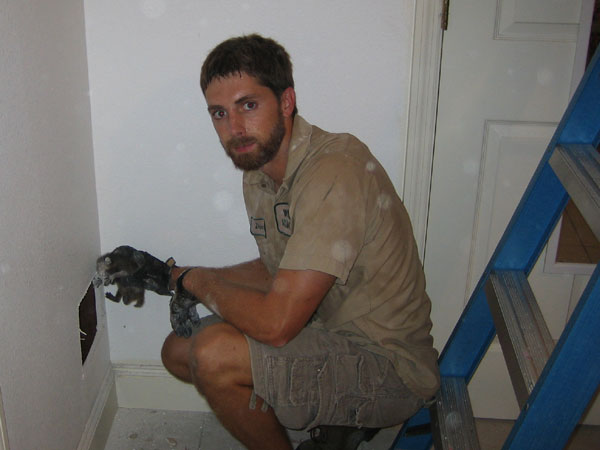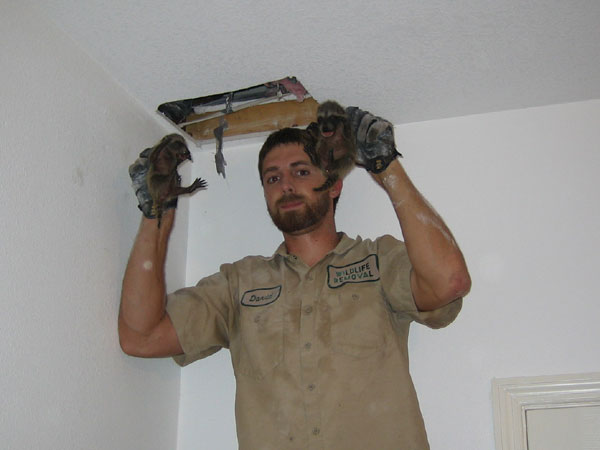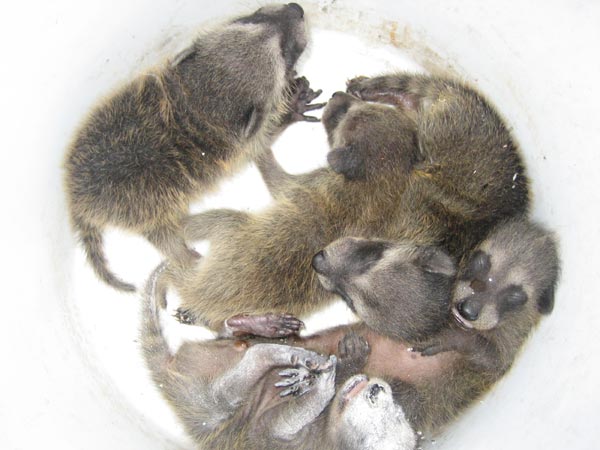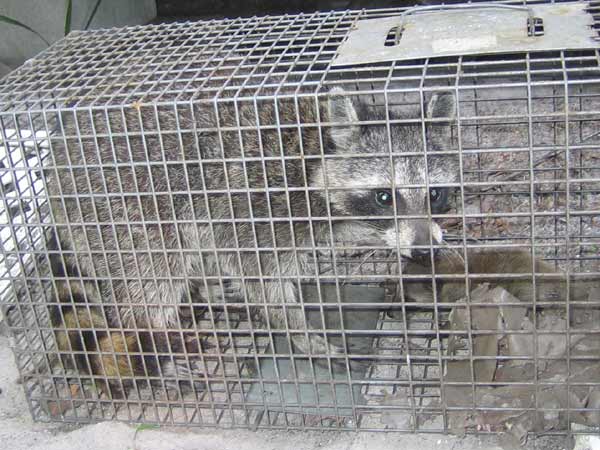I got a typical
call from a home owner. They heard scratching in
the ceiling and down in the wall. Sometimes they
heard heavy noises, sometimes vocal noises, like
chattering. I knew that the culprit was
raccoons. I arrived at the house, and sure
enough, heard some of the scratching noises. It
takes a lot of very careful listening in order
to determine the exact area the babies are in.
In this case, one was down the wall of the home,
and the rest were up in the ceiling between the
1st and 2nd floors.

Once I knew exactly where the noise is
coming from, it's time to cut the proper
hole in the wall. Be sure not to cut too
close to the animal, or you could injure
it!

Here is one baby raccoon. Notice the
white dust covering it, that's from the
drywall cut. There was only one down the
wall. It was a fiesty one, and had
crawled away from the rest of the
litter, and its exploration proved
costly: down the wall it went. Had I not
cut it out, it would have starved to
death, and then caused quite an odor in
the home. The mother raccoon was too big
to go down the narrow wall to save it.

After I got the first one out of the
wall, I had to get the rest of the
litter. They were up in the ceiling.
There was no attic space in this house.
This ceiling was actually between the
first and second floors of the house.
The raccoon was entering the crawl space
under the house and crawling up. In
order to find these babies, I used a
trick I thought up many years ago: I
carefully felt around on the ceiling
until I found a warm spot - and that's
where the litter is resting! I cut a
hole two feet from that area, so as not
to injure the baby raccoons, and removed
four more. Here is a photo of two of
them.

I placed all five baby raccoons together
in a bucket. You can see the one down in
the wall still has a face full of white
drywall powder. The first thing I do is
use the live babies as "bait" to trap
the mother raccoon.

Here you can see the mother raccoon
trapped in a cage, using some of the
baby raccoons as bait. I caught her
under the house, where she had been
gaining access to the walls and the gap
between the floors. Once I have her, I
seal up the entry points, and the
problem is solved. The raccoons are
relocated together.
|
This is not the type of work for amateurs to
attempt. It has taken years of field experience
to do this job right. From subtle things like
using extension mirrors in tight gaps to find
the locations of the raccoon down the wall, to
listening and knowing that the litter isn't all
in one place, to understanding architecture,
raccoon behavior, and ultimately trapping the
raccoon and properly finding and repairing the
entry points, this is a job for an animal pest
control professional. We are actually known as
nuisance wildlife control operators, or animal
damage controllers. If you need help with a
situation like this, and you live in the
Orlando, FL area, give me a call.

For more raccoon trapping information, go back
to the
raccoon
control page.
Read more articles about raccoons:
Are raccoons
dangerous to cats, dogs, or other pets?
Do raccoons eat or
travel in packs?
Can raccoons open
doors or windows?
Can raccoons
jump onto houses or over fences?
How to
identify raccoon tracks
How smart are
raccoons?
How big do raccoons
get?
Do raccoons burrow or
dig holes?
Do raccoons
hibernate?
Do raccoons eat
mice / rats?
Do raccoons
climb fences?
What to do if you are
bitten by a raccoon
What attracts
raccoons?
How to get rid of
raccoons in the attic
Do raccoons
attack people?
What does
raccoon feces look like? Where is it found?
If you don't live in Orlando FL, click here for
the
National
Directory of Wildlife Trappers.
Listen to baby raccoons in the wall or ceiling -
It is important to listen to baby raccoons in
the wall or attic because you’ll need to know
where they are hidden to remove them. You don’t
want to leave a raccoon in your attic. Not only
will she return there for future litters, it is
possible to get some serious illnesses from a
raccoon. Keep in mind that rabies, a fatal
virus, can be contracted at any moment, and a
healthy raccoon can return a few hours later and
be infected with a dangerous disease. Because
your health is on the line, removing the
raccoons is important. Even if you’re not afraid
of getting something like roundworms, you should
worry about the damage being caused to your
home. Though not as destructive as rodents, a
raccoon can just as easily chew through a wire
and cause a house fire. Once you know where the
baby raccoons are, wait until the mother has
left the attic and see if you can go up there
and locate the litter. If you can remove them
and place them in a cage trap, you can then use
the trap to lure the mother inside. Once
reunited, mother and babies can be moved to a
safe area.
Raccoon in walls - Most of the time when you
have a raccoon in the wall you can fish the
problem animal out with a snare pole. Since the
majority of homeowners don’t have snare poles,
this might be a situation best left to a
professional. The raccoons in the walls are
usually adolescents or very young kits. A mother
raccoon is too large to live comfortably in the
wall space. She’ll spend most of her time in the
attic or the crawlspace above the wall opening.
This will allow you to trap the mother the
traditional way by anchoring a cage trap to the
hole she is entering through or by setting up a
baited trap on the ground. If the raccoons are
in the external wall where you can’t access them
through the attic, you’re only recourse will be
to find their heat signature and cut into the
wall. This can be very tricky, and you need to
be prepared to immediately grab and confine a
handful of adolescent raccoons. IF you’re
working on a ladder on the outside of your home,
it might be best to try this tactic when someone
is around to help you.
I operate a professional wildlife removal and
pest animal control business in Orlando Florida.
I deal with wild critters and control them via
trapping, exclusion, and prevention techniques.
If you have to know
how
to get raccoons out of the attic and need
to know
how
to get rid of raccoons on your property,
give me a call any time and I can professionally
take care of your Orlando raccoon problem.